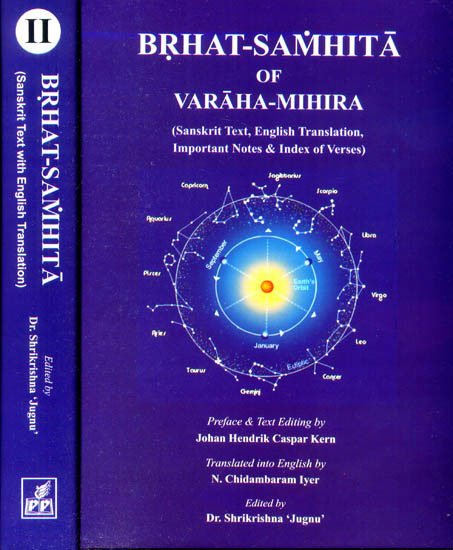Brihat Samhita
by N. Chidambaram Iyer | 1884 | 135,584 words | ISBN-13: 9788171104215
This is the English translation of the Brihat-samhita, one of the fundamental works of ancient Indian astronomy (known as Jyotisha). It was written in the 6th century A.D. (or 1st century B.C.) in about 4000 Sanskrit verses (slokas) by the polymath known as Varahamihira, who was considered as a great scientific scholar of mathematics, astronomy and...
Preface
Bharata Varsha has long continued to be the centre of attraction not only in respect of its wealth and civilization but in that of its intellectual advancement. To it converged, as to a common focus, the eyes of foreigners from the earliest period of the world's history. It was the one fountain of knowledge from which issued streams to water distant lands of ignorance at every point of the compass, now yielding abundance of intellectual harvest. Time was when Aryan wisdom shone resplendent, and, from its eminence, dazzled the eyes of distant nations—distant geographically and distant chronologically,—illumined every corner of the intellectual horizon and served as a beacon, lighting the paths of erring travellers. History is puzzled in its attempt to reach the date of Aryan civilization. Antiquarians are at logger-heads in their conclusions touching the age of Aryan learning. Though at loggerheads most of the Christian antiquarians take care not to assign to any Indian event dates earlier than what is permissible under their Biblical Chronology.
Now it is well known that Aryan learning dates from the remotest antiquity. The Aryans have cultivated almost every department of knowledge. As the art of printing was unknown a large proportion of Aryan literature has been washed into oblivion by the mighty wave of time. Not a few remain,
“Like stranded wrecks the tide returning hoarse
To sweep them from our sight”.
unless rescued from their fate. Our excellent Government are now laudably working in this direction. But most of the Hindus, of the present day, can neither use the books them selves nor will they allow foreigners to interfere with their sacred literature.*
* And not without reason; it may not be out of place to quote here a little from Louis Jacolliot’s “Bible in India”;
“The Reverend Fathers, Jesuits, Franciscans, Stranger-missions and other corporations unite with touching harmony in India to accomplish a work of Vandalism, which it is right to denounce as well to the learned world as to Orientalists. Every manuscript, every Sanscrit work that falls into their hands, is immediately condemned and consigned to the flames. Needless to say that the choice of these gentlemen always falls from preference upon those of highest antiquity, and whose authenticity may appear incontestable.”
“Every new arrival receives a formal order, so to dispose of all that may fall into his hands. Happily the Brahmins do not open to them the secret stores of their immense literary wealth, philosophic and religions”.
The public can therefore do much if their eyes could only be opened to the importance of the subject. Moat of the English knowing natives hardly know what these books treat of. I have many a time astonished young Collegians and graduates by quoting from Hindu astronomers and mathematicians, and they were surprised to find that the Aryans knew what the Europeans know forgetting that these sciences were taken to the west from here.[1]
Now it has come to my knowledge that in many Hindu families whole libraries, for want of inspection, are now being feasted on by moths and white ants and large quantities have already been emptied into the dustbins, the decay having gone too far I know that at this moment over 50 books are being exposed to sun and rain in a well-known family here and I bear they have remained in that state for over four years. This meritorious act is no doubt due to the circumstance that the present owners of the books have begun to taste the sweets of English education, while their ancestors appear to have been men of learning. My attempts to rescue them from further ruin proved a complete failure. The books appear to have, by a peculiar process, melted together and formed into one brittle mass. Similar injuries to Aryan literature are more or less going on all over India. English education, like Aaron's rod, appears to have devoured up every other education and it has spread now throughout the land.
In the humble hope that the progressing ruin might be in a measure retarded, it is proposed to tell the present Indian generation, in the language in which they will all and can all hear that, if they would exert a little, they might rescue from ruin avast amount of splendid Aryan literature: in other words, it is proposed to publish an English translation of Aryan Miscellany. As the prosperity of a nation depends on its literature, the public are requested to form into societies for the collection and preservation of Aryan works and for the printing of the more important of them. They will also kindly communicate to me the names and particulars of Aryan works falling within their notice.
The Samhita series is taken up first as being best calculated to awaken public interest and arrest public attention on account of the interesting variety of the subjects treated of.
Madura,
1st October 1884.
N. C.
Footnotes and references:
[1]:
It may be mentioned here, in passing, that these Sciences, so much, neglected by the State, stand a fair chance of being revived as, at my suggestion a Sanskrit Mathematical class has recently been opened in the Maharajah’s free Sanskrit College, Tiruvadi, Tanjore District, and placed under the management of Brahma Sree Sunderaswara Srouthy, Hindu Astronomer and Almanac publisher.
